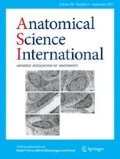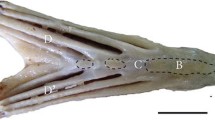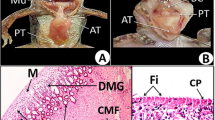Abstract
During an organism’s evolution, functional adaptations help species to become better suited to their ecological niches. From the morphological aspect, these adaptations are reflected in the anatomical specializations of different organs. Specializations of the lingual organ is a critical adaptation of birds, such as the white-headed duck (Oxyura leucocephala), that enables their nutritional requirements to be met. For optimal use of the available food resources, the white-headed duck utilizes three methods of food collection, namely pecking, grazing and filter-feeding. Since this species is classified as endangered, we conducted the present study on two carcasses of the white-headed duck (death due to natural causes) employing routine histological methods, light microscopy and scanning electron microscopy. Our results show that the tongue of this bird shares some similarities and some differences with the tongue of other members of the family Anatidae. The results confirm that it is better adapted to the filter-feeding method rather than to other types of food intake. This adaptation is reflected by anatomical specializations of its lingual structures, including the stair-like outline shape, bi-sectional lingual body, a deep median sulcus, lateral conical papillae, mucus secreting glands, lack of serous secreting glands, cartilaginous skeleton and the triangular fibromuscular structure of the lingual body. The so-called triangular structure and cartilaginous skeleton are the major structures involved in the lingual motions during the filter-feeding method. The presence of the triangular structure and its connection with the cartilaginous skeleton and lingual mucosa have not previously been reported in any species of birds.






Similar content being viewed by others
Change history
19 May 2018
The affiliation of the third author has been incorrectly published in the original publication of the article. The correct affiliation is provided in this erratum.
References
Atiénzar F, Antón-Pardo M, Armengol X, Barba E (2012) Distribution of the white-headed duck Oxyura leucocephala is affected by environmental factors in a Mediterranean wetland. Zool Stud 51:783–792
Baussart S, Bels V (2011) Tropical hornbills (Aceros cassidix, Aceros undulatus, and Buceros hydrocorax) use ballistic transport to feed with their large beaks. J Exp Zool Part A Ecol Genet Physiol 315:72–83
Chettibi F, Khelifa R, Aberkane M, Bouslama Z, Houhamdi M (2013) Diurnal activity budget and breeding ecology of the white-headed duck Oxyura leucocephala at Lake Tonga (North-east Algeria). Zool Ecol 23:183–190
del Hoyo J, Collar NJ, Christie DA, Elliott A, Fishpool LDC (2014) HBW and BirdLife illustrated checklist of the birds of the world. Vol 1: non-passerines. Lynx Edicions/BirdLife International, Barcelona/Brussels
Emura S, Okumura T, Chen H (2008) Scanning electron microscopic study of the tongue in the peregrine falcon and common kestrel. Okajimas Folia Anat Jpn 85:11–15
Erdogan S, Iwasaki S (2014) Function-related morphological characteristics and specialized structures of the avian tongue. Ann Anat 196:75–87
Green AJ, Hughes B (1996) Action plan for the white headed duck (Oxyura leucocephala) in Europe. In: Heredia B, Rose L, Painter M (eds) Globally threatened birds in Europe. Council of Europe Publishing, Strasbourg, pp 119–146
Hutchinson GE (1965) The ecological theater and the evolutionary play. Yale University Press, 1965
Igwebuike UM, Anagor TA (2013) The morphology of the oropharynx and tongue of the muscovy duck (Cairina moschata). Vet Arhiv 83:685–693
Jackowiak H, Skieresz-Szewczyk K, Godynicki S, Iwasaki S, Meyer W (2011) Functional morphology of the tongue in the domestic goose (Anser anser f. Domestica). Anat Rec 294:1574–1584
Mayr E (1966) Animal species and evolution. Belknap Press of Harvard University Press, Cambridge
Nickel R, Schummer A, Seiferle E (1977) Anatomy of the domestic birds. Verlag Paul Parey, Berlin
Parchami A, Dehkordi RAF, Bahadoran S (2010a) Fine structure of the dorsal lingual epithelium of the common quail (Coturnix coturnix). World Appl Sci J 10:1185–1189
Parchami A, Dehkordi RAF, Bahadoran S (2010b) Scanning electron microscopy of the tongue in the golden eagle Aquila chrysaetos (Aves: Falconiformes: Accip-itridae). World J Zool 5:257–263
Sanchez MI, Green AJ, Dolz JC (2000) The diets of the White-headed Duck Oxyura leucocephala, Ruddy Duck O. jamaicensis and their hybrids from Spain. Bird Study 47:275–284
Skieresz-Szewczyk K, Jackowiak H (2016) Morphofunctional study of the tongue in the domestic duck (Anas platyrhynchos f. domestica, Anatidae): LM and SEM study. Zoomorphology 135:255–268
Van der Leeuw AHJ, Kurk K, Snelderwaard PC, Bout RG, Berkhoudt H (2003) Conflicting demands on the trophic system of Anseriformes and their evolutionary implications. Anim Biol 53:259–301
Acknowledgements
This work was financially supported by research council of University of Tabriz (project number 3379).
Author information
Authors and Affiliations
Corresponding author
Ethics declarations
Conflict of interest
All authors declare that they have no conflict of interest.
Rights and permissions
About this article
Cite this article
Akbari, G., Hassanzadeh, B., Madadi, M.S. et al. Morphological reflections of evolutionary adaptations in the tongue of the white-headed duck. Anat Sci Int 93, 469–477 (2018). https://doi.org/10.1007/s12565-018-0438-x
Received:
Accepted:
Published:
Issue Date:
DOI: https://doi.org/10.1007/s12565-018-0438-x




